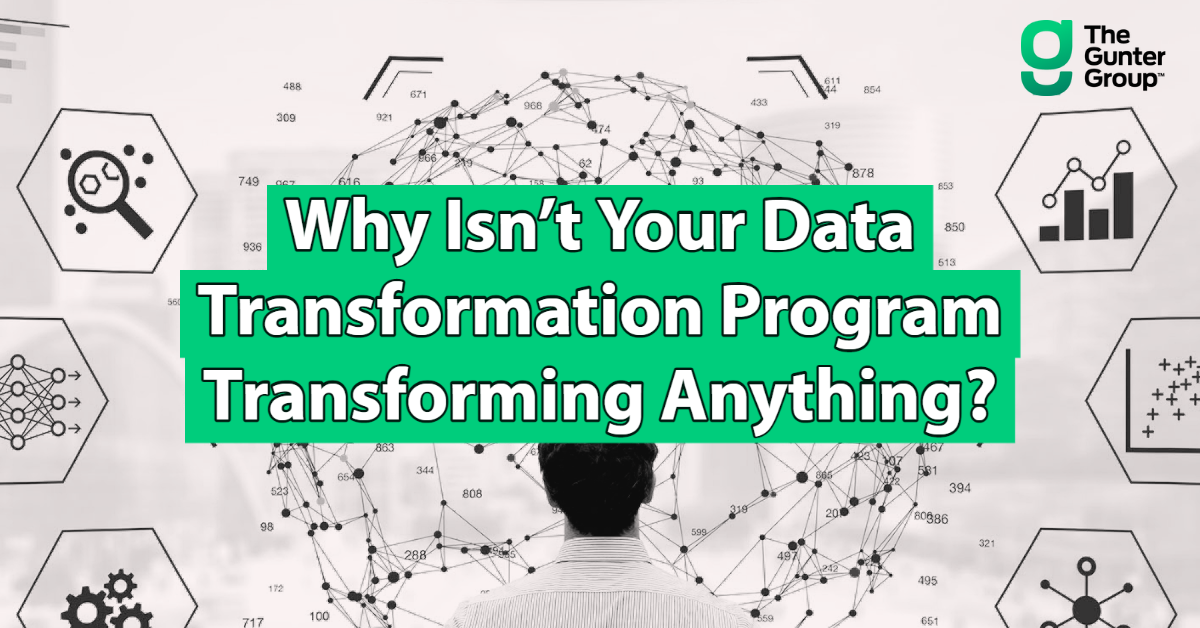It’s a familiar tale — you’ve embarked on a journey to transform the way your company uses data, but all you have to show for it is a lot of very ambitious documentation and hundreds of progress update meetings where time feels like it’s standing still.
Why isn’t your in-progress data transformation program producing tangible results? Here are three common reasons why your efforts might be failing to deliver:
1. Your approach isn’t incremental.
We recently wrote about data maturity models and how they can actually hinder data transformation if you don’t apply them correctly. To summarize, organizations tend to focus too much on the brass ring (reaching some proverbial data maturity nirvana) and not enough on the details (getting more value from data along the way).
Often, the goal is a total overhaul of how data is used from the top to bottom of the business, delivering unimaginable value to everyone, everywhere — an ambitious transformation that will take years to achieve. Even if you’ve had a few updates and helpful process changes along the way, most of the value remains locked behind the “project completion” door.
What does that mean for those who are trying to get some incremental improvement and use data more effectively in the near term? It means they have to just sit tight and wait for the big reveal — otherwise, they’ll be doing work that’s not aligned with the broader strategy.
It’s important to consider the folks in your organization who use data to complete everyday tasks, and how you can make their jobs easier, not harder, during the data transformation process.
2. Technical debt is handcuffing you.
Individual innovation can be a huge asset for an organization. You want people to take initiative, solve problems, and make it happen. But when it comes to managing data, all that individual problem solving can add up to huge technical debt, and make organization-wide data transformation efforts feel insurmountable.
When everyone has their own unique, siloed quick fixes and band-aid solutions, there’s no more unifying structure left to transform — so where do you even start? Think of the chaos you’d unleash by pulling at even one loose thread; mission-critical systems that were crudely patched together would come tumbling down.
As an additional challenge, there will always be responsibilities and processes that can’t be switched off while things are fine tuned. For example, if you’re using your existing data systems to calculate monthly commissions, that presents a huge barrier to making any meaningful changes — you can’t stop paying out commissions until changes are implemented, and it would be risky to just cross your fingers and hope that brand new systems produce accurate results in time for you to cut checks.
Getting out from under technical debt isn’t impossible — it just requires a lot of effort. It’s also infinitely easier to achieve with the right combination of planning, skill, and resources, which is why many companies partner with firms that specialize in tackling technical debt.
It’s also important to remember that tech debt isn’t something you can escape completely, but a challenge that needs to be continually addressed. Good solution design assumes that today’s new solution is tomorrow’s tech debt, everything is eventually deprecated, and all solutions incur maintenance and upkeep. Finding the balance between standardization and innovation is important, as too much of either can be stifling.
3. You don’t have the right people.
Pulling off a successful data transformation project takes a lot of skill sets (strategic planning, project management, change management, ETL development, data science, etc.), and it’s highly unlikely that you’re going to find a single person who can do them all well. It’s also unrealistic to expect your current staff to sustain day-to-day operations and magically find the time to make changes. In 99% of cases, you’ll need outside help.
Trying to build an in-house team is difficult, especially in the midst of a data analytics talent shortage. Planning and recruiting for a team can take anywhere from six months to a year, plus the time it takes to get everyone up and running. If your organizational culture (or even just a particular decision maker) is change-resistant, this process can take even longer — and feel like pulling teeth.
Technical leaders often have to spend a large amount of time jockeying for resources and pitching projects. You may have to argue and advocate for three months to hire one person that was needed to solve a problem three months ago. By the time you get a decision, you’re going through the same cycle with a different problem.
It’s easy to see how years can go by with little to no progress.
This is another situation where it can be helpful to work with a data transformation partner, which gives you access to highly skilled, experienced people, without the pressure or long timeline of trying to build an in-house team.
Conclusion
Our general advice for data transformation can be summed up in two words: don’t wait. Every day you remain stalled out, you acquire more technical debt, and your problems get more complex. You lose more business, you gain less on your competition, and your company loses value.
If you need to see real outcomes from a data transformation project, focus on incremental improvements, and find a partner who can help you overcome the challenges we’ve outlined here.
Above all, remember that data transformation isn’t a “project” that begins and ends. It’s a decision to become a data-oriented organization — and it takes continuous effort and agility.
Not seeing results from your data transformation initiatives? Discover how to improve your data infrastructure and decision making during our upcoming Data Maturity workshop on December 15th at 11:30am Pacific Time.


